Here’s the master distribution graph for the 2011 list, and the ones for the previous four years for comparison. The solid lines in the graphs are all 4th order polynomial trend lines.
2011
2010
2009
2008
Now, for specific changes between the 2010 and 2011 lists:
New movies on the 2011 list
| Title | Year | Rank | Rating |
| Drive | 2011 | 114 | 8.2 |
| Harry Potter and the Deathly Hallows: Part 2 | 2011 | 133 | 8.2 |
| A Separation | 2011 | 207 | 8 |
| Black Swan | 2010 | 113 | 8.2 |
| The King’s Speech | 2010 | 125 | 8.2 |
| The Social Network | 2010 | 220 | 8 |
| Shutter Island | 2010 | 238 | 8 |
| Elite Squad: The Enemy Within | 2010 | 246 | 8 |
| Mary and Max | 2009 | 195 | 8 |
| Ip Man | 2008 | 241 | 8 |
| Spring, Summer, Fall, Winter… and Spring | 2003 | 247 | 8 |
| A Beautiful Mind | 2001 | 242 | 8 |
| The Celebration | 1998 | 233 | 8 |
| Beauty and the Beast | 1991 | 249 | 8 |
| Fanny and Alexander | 1982 | 210 | 8 |
| Stalker | 1979 | 243 | 8 |
| Persona | 1966 | 200 | 8 |
| The Man Who Shot Liberty Valance | 1962 | 237 | 8 |
| Tokyo Story | 1953 | 248 | 8 |
| His Girl Friday | 1940 | 250 | 8 |
| The Passion of Joan of Arc | 1928 | 212 | 8 |
| Sherlock Jr. | 1924 | 221 | 8 |
Where are the recent summer movies? Many of the big winners of the 2010 Academy Awards have made their way onto the 2011 list, but none of the 2010 summer fan favorites, and only one from the 2011 summer season. Compare that to the 2010 summer hits that made it onto the 2010 list: Inception, Toy Story 3, How to Train Your Dragon, and Kick-Ass. Conclusion: the 2011 summer movie season was weak. But you didn’t need statistics or the IMDb list to tell you that.
Movies on the 2010 list that dropped off the 2011 list
| Title | Year | Rank | Rating |
| Kick-Ass | 2010 | 195 | 8 |
| Letters from Iwo Jima | 2006 | 214 | 8 |
| Little Miss Sunshine | 2006 | 244 | 7.9 |
| Crash | 2004 | 225 | 8 |
| Mulholland Dr. | 2001 | 247 | 7.9 |
| Wo hu cang long | 2000 | 240 | 7.9 |
| Toy Story 2 | 1999 | 229 | 8 |
| The Nightmare Before Christmas | 1993 | 241 | 7.9 |
| Edward Scissorhands | 1990 | 250 | 7.9 |
| The Conversation | 1974 | 233 | 8 |
| Planet of the Apes | 1968 | 230 | 8 |
| Bonnie and Clyde | 1967 | 223 | 8 |
| Spartacus | 1960 | 242 | 7.9 |
| Anatomy of a Murder | 1959 | 236 | 8 |
| The African Queen | 1951 | 221 | 8 |
| Harvey | 1950 | 202 | 8 |
| Brief Encounter | 1945 | 217 | 8 |
| Arsenic and Old Lace | 1944 | 249 | 7.9 |
| Shadow of a Doubt | 1943 | 215 | 8 |
| The Adventures of Robin Hood | 1938 | 246 | 7.9 |
| King Kong | 1933 | 208 | 8 |
| Duck Soup | 1933 | 224 | 8 |
So much for Kick-Ass. Great movie, but…Top 250 great? (Duke it out in the comments.)
Not much else to say here, except to repeat the annual ritual of lamenting the cruelty of the IMDb algorithm that pushes out classic movies to make room for new “classics.” Notably, the original Planet of the Apes has left the list in the same year that a new Planet of the Apes movie received high critical and audience praise. Fellow gorilla-themed classic King Kong is also gone, meaning that these Damn Dirty Apes have gotten their paws off of the IMDB Top 250 List…for now.
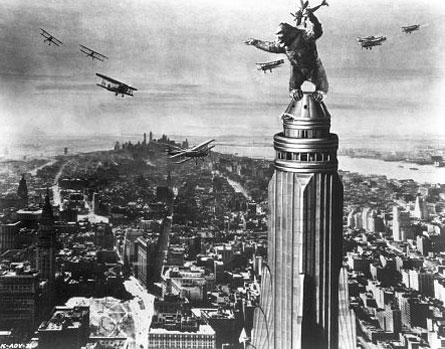
CGI? We don't need no stinkin' CGI.
Conclusion
Looking back at the comments on these articles over the past few years, it’s clear that these lists and their content get people really worked up, in spite of all of the caveats downplaying any authority that the IMDb list may carry and the authority that any ranking list done on subjective grounds may carry.
So rather than try to tell people not to read into this too much, I’m going to give the opposite advice for those wishing to comment on this article: read into it all you want. If you think the data says something about the changing tastes of our times, the intensifying fanboy effect on IMDb rankings, the downfall of the art of film, or the downfall of Western Civilization, let it be known. If you think this is a pointless exercise and that I should be using Excel for more interesting pop culture analysis, let it be known.
Oh, and speaking of Excel, if you want to do your own analysis, you can either download my datasets for 1996-2011 or grab some for yourself at the IMDB Top 250 History site.
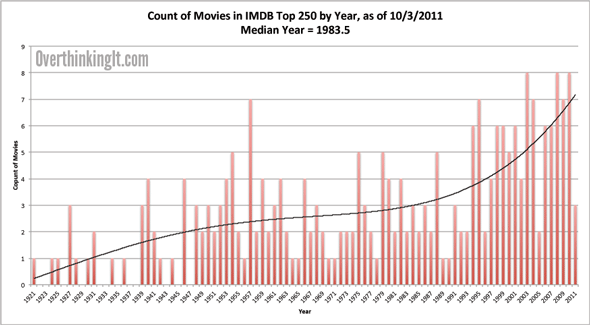
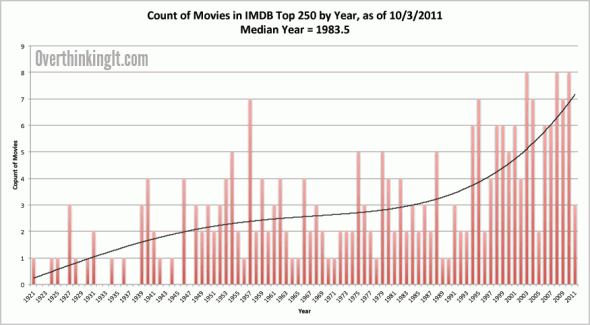
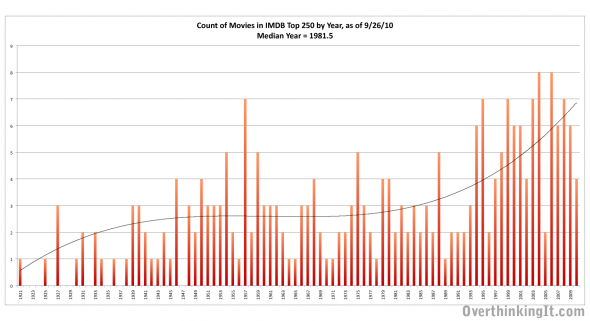
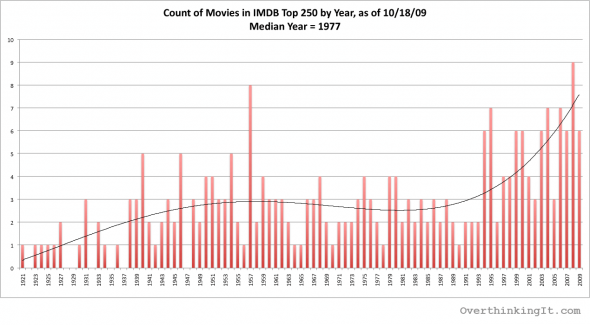
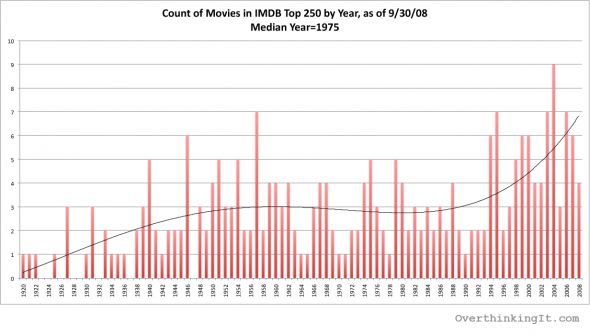
I know the dataset is likely too small, but does it implies that between 1998 and 1999 the imdb userbase started paying attention to more classic movies? Were there some big rereleases that year, perhaps, and now we are restoring the original 96/97 status quo?
Wasn’t the original Star Wars trilogy re-released in Theatres around that time?
I wonder how much influence Netflix Instant Streaming has on the new list.
Mulholland Drive OFF THE LIST???
Seriously, wtf??!
I think you’re missing a huge variable. The number of movies produced per year is now a lot higher than it was years ago. Therefore even if the average movie rating and variance stayed the same over time, you’d expect to see more recent films in the top 250.
I agree. The number of films being released per year in the states and abroad is much higher in the last 20 years than it ever was in the past. The rate at which technology can allow more and more film makers to make films of varying budgets is very high and although all the top 250 are big releases, it also means an increase the amount of films in existence, meaning the average score of all movies is skewed by the adding new scores and thus the population can manipulate scores based on changing tastes, with adjustments for population increases. Of course older films are going to get snubbed, especially when it becomes increasingly harder for audiences to find copies on changing formats. Does Netflix even have Arsenic and Old Lace? How many people today consistently watch films from before 1975?
Netflix has Arsenic and Old Lace, both DVD and streaming! I’m one of those weird people that most the movies I watch are older than 1975, with only a few newer ones thrown in.
Um…me? Joan Crawford and Katharine Hepburn are the s**t.
I see two possible reasons for the odd shape of the Historical Median graph (one for each end):
1- At the beginning, the IMDB was incomplete. It would take a couple of years to get every movie ever made entered in sufficient detail and rated accurately. The initial list would have had a bias toward newer movies because an accurate rating would have been easier to get.
2- As of late, there have been a large number of remakes of movies. These new versions of movies are taking precedence over the older originals. I suspect that people are mistakenly rating the new version of Straw Dogs when they mean to rate the original or vice versa. This would dilute the scores of older movies, allowing newer movies to push out both the new and old versions of remakes, thus skewing the the median.
Or it’s the political affiliation of the president.
So, in 2071, some of the top movies will be ones that haven’t been released yet? Since IMBD lets you post reviews and rate movies before they are officially released (e.g. “Red State”), it wouldn’t surprise me.
It might also be interesting to look at the rankings of specific movies as they change over time. What genre of movie is more likely to have a high initial ranking before falling off the Top 250 entirely? Do remakes or originals have more “staying power”? Which movies have a fairly constant ranking?
The number of votes back in 1996 is interesting – Empire Records comes in at 98th best movie ever, with 252 votes. Odd that it drops off the list after that, poor forgotten masterpiece that it is.
It would be interesting to see the data broken out by time period of the vote, on the assumption that IMDB’s user base demographics changed rapidly in the early days of the web. One could roll individual movies through into such a year breakout by treating the prior year’s cumulative votes as if they were all pegged at the prior year’s aggregate score.
The first step would be a rating difference like you calc’d for the ranking difference. Just eyeballing Empire Strike’s Back, for instance, the rating drifts upward from 8.1 in 1996 to 8.8 in 2011. Braveheart goes from 8.5 to 8.3 – I wonder if Mel Gibson’s movies started to drift south as his antics got crazier off screen.
I downloaded your generous excel workbook, but did you consider uploading it to Google Docs, so derivative analysis like that could be shared?
This effect might be buried by the number of votes, but it would be interesting to see how the release of the Criterion edition of a movie affects voting. Or director’s cuts that made significant changes, like the final release of Bladerunner without the narration and with the original score restored.
inmate has some reason in his first point. Early web access was not yet widespread and most of web surfers were colleague student (20-somethings)and older people which still represented a good percentage overall. Maybe this trend was still present until early 2000s.
Now we have web access available to anyone since kindergarten, more younger people vote in what they (can) see.
To add to what Jota and inmate mentioned, the issue of skewed demographics from 1996 until now is such a major factor in looking at the data that it almost in and of itself proves why the IMDB 250 is too weak to take seriously. So considering that the IMDB in the 90’s was more obscure than it is now, the demographics were probably mostly over 20. As internet usage increases over the years, the user base demographics skew younger and younger, meaning that even if they would love older movies, most of them haven’t even had a chance to see most of them yet in their lifetime. If the user base skews more towards younger viewers than older ones, their frame of reference for what they like and what they don’t like is much more limited. Even though the IMDB algorithm tries hard to account for this, it still falls victim to it more often than not.
I would think that Netflix would spur more watching of old movies. Years ago, the only options for watching a movie were going to the store or watching what was on TV and both of those were biased towards newer, more recognizable movies.
In the Netflix era, anyone who reads a reference to an old movie online or reads a “Best Movies Ever” type of list can immediately go to Netflix and order/stream an older movie that looks interesting.
Here’s one thing that I find somewhat telling-films specifically aimed at children seem to be skewed more toward recent releases. Toy Story 3, for instance, is way up at #35, while Toy Story 2 falls off the list, and the original is way down at #135.
One of the definitive Disney classics remains on the list, “The Lion King,” at #117-I don’t know how much of that is due to the attention it’s getting from its re-release. But you don’t see “Snow White,” or “Beauty and the Beast,” on there. What you do see trends heavily toward the last 5 years: Ratatouille, How to Train Your Dragon, Up, and Wall-E, in addition to the aforementioned Toy Story 3. I’d expect to see Monsters, Inc. and The Incredibles drop off the list soon, and Ratatouille and How to Train should probably slide down significantly.
Generally, I would imagine a well written movie targeted at kids to be a good bet for an instant splash, especially if it’s good enough that somewhat older audiences who see it will also enjoy it. But those will have limited staying power, as the most effective audience will have aged out of their devotion to them.